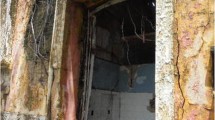Abstract
Structural health monitoring (SHM) is the process of continuously or periodically measuring structural parameters over time and the transformation of the acquired data into information about the actual structural behavior. The main goal of SHM is to provide quantitative and actionable information to infrastructure managers on a system-wide level. However, to achieve this goal, damage sensitive universal parameters need to be researched, identified, and implemented into SHM processes and data analysis. The neutral axis location has been identified as a potential parameter for damage detection, performance evaluation, and condition assessment of beam-like structures. This paper is intended to serve as a reference for researchers who are interested in the state of the art in evaluation of the neutral axis location, facts about the neutral axis behavior, and challenges associated with using the neutral axis for SHM purposes. Studies of the neutral axis in laboratory settings, controlled on-site testing, and on real structures in on-site conditions are presented and discussed. The main difficulties in using the neutral axis location for SHM purposes that are identified in this paper are: (1) its sensitivity to environmental effects such as temperature, humidity, and loading positions, (2) its natural variation in healthy cross-sections, (3) quantification of its sensitivity to damage, i.e. its damage detection capabilities in terms of the damage size and its distance from sensors, and (4) correlation between the neutral axis location and the capacity, performance, and condition of the monitored structure. The proof of concept has been provided with numerical modeling, and in the laboratory, and to some extent through controlled testing; however, a general on-site validation still remains a major challenge.









Similar content being viewed by others
References
Navier M (1826) Résumé des leçons données à L’École royale des ponts et chaussées. Firmin Didot, Paris
Rc Hibbeler (2014) Mechanics of materials, 9th edn. Prentice Hall (Pearson), Upper Saddle River
Nilson A, Darwin D, Dolan C (2009) Design of concrete structures, 14th edn. McGraw Hill Higher Education, New York
Plude R, Christenson J, DeWolf J, Jamalipour A (2011) Quantifying damage measures for a composite steel girder bridge using finite element analysis. In: Structural health monitoring 2011: condition-based maintenance and intelligent structures—proceedings of 8th international workshop on structural health monitoring, Stanford University
Green R (1975) Post-tensioned slab bridges on isolated supports. J Struct Div 101(1):233–247
O’Brien EJ, Keogh DL (1999) A discussion on neutral axis location in bridge deck cantilevers. Comput Struct 73:295–301
Sigurdardottir DH, Glisic B (2013) Neutral axis as damage sensitive feature. Smart Mater Struct 22(7):Article No. 075030 (18 pp)
Nakamura S, Hosaka T, Nishiumi K (2004) Bending behavior of steel pipe girders filled with ultralight mortar. ASCE J Bridge Eng 9(3):297–303
Stroh SL, Sen R, Ansley M (2010) Load testing a double-composite steel box girder brigde. Transp Res Rec J Transp Res Board 2200:36–42
Papastergiou D, Lebet JP (2014) Design and experimental verification of an innovative steel-concrete composite beam. J Constr Steel Res 93:9–19
Park KT, Kim SH, Lee YH, Hwang YK (2006) Degree of composite action verification of bolted GFRP bridge deck-to-girder connection system. Compos Struct 72:393–400
Elhelbawey M, Fu CC, Sahin MA, Schelling DR (1999) Determination of slab participation from weigh-in motion bridge testing. J Bridge Eng 4(3):165–173
Gangone MV, Whelan MJ, Janoyan KD (2011) Wireless monitoring of a multispan bridge superstructure for diagnostic load testing and system identification. Comput Aided Civ Infrastruct Eng 26(7):560–579
Gangone MV, Whelan MJ, Janoyan KD, Minnetyan L (2014) Development of performance assessment tools for a highway bridge resulting from controlled progressive monitoring. Struct Infrastruct Eng Maint Manag Life Cycle Des Perform 10(5):551–567
Gangone MV, Whelan MJ, Janoyan KD, Minnetyan L (2012) Experimental characterization and diagnostics of the early-age behavior of a semi-integral abutment FRP deck bridge. Sens Rev 32(4):296–309
Sigurdardottir DH, Glisic B (2014) Detecting minute damage in beam-like structures using the neutral axis location. J Smart Mater Struct 23(12):Article No 125042 (15 pp)
Sigurdardottir DH (2015) Strain-based monitoring methods for beam-like structures. PhD Thesis Princeton University
Oshima Y, Kado M (2012) Long-term monitoring of composite girders using optical fiber sensor. In: Bridge maintenance, safety, management, resilience and sustainability. Proceedings of the sixth international IABMAS conference, Stresa, Lake Maggiore, Italy, pp 777–781
Rauert T, Feldmann M, He L, De Roeck G (2011) Calculation of bridge deformations due to train passages by the use of strain and acceleration measurements from bridge monitoring supported by experimental results. In: Proceedings of the 8th international conference on structural dynamics, EURODYN 2011, Leuven, Belgium, pp 1149–1155
Chakraborty S, DeWolf JT (2006) Development and implementation of a continuous strain monitoring system on a multi-girder composite steel bridge. J Bridge Eng ASCE 11(6):753–762
Cardini AJ, DeWolf JT (2009) Long-term structural health monitoring of a multi-girder steel composite bridge using strain data. J Struct Health Monit 8(1):47–58
Acknowledgments
This material is based upon work supported by the Leifur Eiriksson Foundation, the USDOT-RITA UTC Program, Grant No. DTRT12-G-UTC16, enabled through the Center for Advanced Infrastructure and Transportation (CAIT) at Rutgers University, and the National Science Foundation under Grant No. CMMI-1362723. Any opinions, findings, and conclusions or recommendations expressed in this material are those of the authors and do not necessarily reflect the views of the Leifur Eiriksson Foundation, USDOT-RITA, or the National Science Foundation.
Author information
Authors and Affiliations
Corresponding author
Rights and permissions
About this article
Cite this article
Sigurdardottir, D.H., Glisic, B. The neutral axis location for structural health monitoring: an overview. J Civil Struct Health Monit 5, 703–713 (2015). https://doi.org/10.1007/s13349-015-0136-5
Received:
Revised:
Accepted:
Published:
Issue Date:
DOI: https://doi.org/10.1007/s13349-015-0136-5




